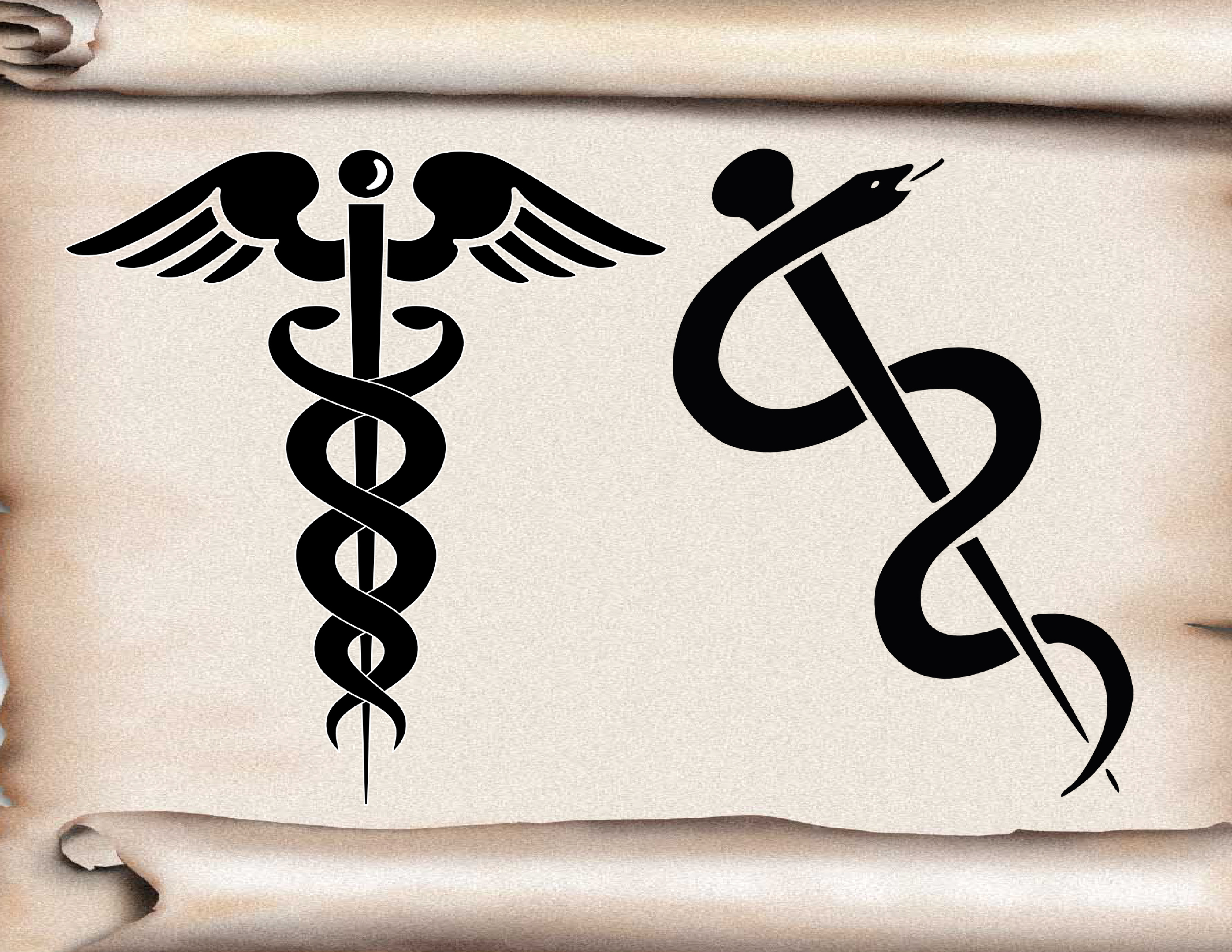 Submitted by Mad Max on
Submitted by Mad Max on

derivativeimages
The Caduceus of Hermes
The Greek Hermes found his analogue in Egypt as the ancient Wisdom god Thoth, as Taaut of the Phoenicians and in Rome as the god Mercury (all linked with a magic rod with twin snakes).
The mythical origin of his magic twin serpent caduceus is described in the story of Tiresias. Poulenc, in "Les Mamelles de Tiresias" (The Breasts of Tiresias) tells how Tiresias--the seer who was so unhelpful to Oepidus and Family- found two snakes copulating, and to separate them stuck his staff between them. Immediately he was turned into a woman, and remained so for seven years, until he was able to repeat his action, and change back to male. The transformative power in this story, strong enough to completely reverse even physical polarities of male and female, comes from the union of the two serpents, passed on by the wand. Tiresias' staff, complete with serpents, was later passed on to Hermes...
Occult Hermetic Connection: An occult description of the Caduceus of Hermes (Mercury) is that the serpents may represent positive and negative kundalini as it moves through the chakras and around the spine (the staff) to the head where it communicates with MIND by intellection, the domain of Mercury [wings].
Caduceus Power Wand: This wand is sold at occult, new age & witchcraft stores such as Abaxion with descriptions such as "It's central phallic rod represents the potentiality of the masculine, and is initmately surrounded by the writhing, woven shakti energies of two coupling serpents. The rod also represents the spine [sushumna] while the serpents conduct spiritual currents [pranas] along the ida and pingala channels in a double helix pattern from the chakra at the base of the spine up to the pineal gland".
According to occultists, there are three principal nadis (Sanskrit for channel) in the human body. The sushumna (the spinal column through which the life-forces flow), by which means we enter and leave the body, the Ida (refreshment and stimulation of spirit), which is associated with the higher mind or manas and the Pingala, (reddish-brown), associated with kama or the force of desire. (G. de Purucker "Man in Evolution" ch. 15 & 16; and "Fountain-Source of Occultism", pp. 458-63).
Hermetic: There are few names to which more diverse persons and disciplines lay claim than the term "Hermetic". Alchemists have applied the adjective "Hermetic" to their art, while magicians (not the entertaining type) attach the name to their ceremonies of evocation and invocation. Followers of Meister Eckhart, Raymond Lull, Paracelsus, Jacob Boehme, and most recently Valentin Tomberg are joined by academic scholars of esoterica, all of whom attach the word "Hermetic" to their activities.
The most abiding impact of Hermeticism on Western culture came about by way of the heterodox mystical, or occult, tradition. Renaissance occultism, with its alchemy, astrology, ceremonial magic, and occult medicine, became saturated with the teachings of the Hermetic books. This content has remained a permanent part of the occult transmissions of the West, and, along with Gnosticism and Neoplatonism, represents the foundation of all the major Western occult currents. Hermetic elements are demonstrably present in the Rosicrucian and Theosophical movements.
The caduceus in pseudo-science: There are amazing claims that a Cadeuceus Power Wand has zero impedance and infinite resonance! -check it out here .
The caduceus as a Medical symbol: The link between Hermes and his caduceus and medicine seems to have arisen by Hermes links with alchemy. Alchemists were referred to as the sons of Hermes, as Hermetists or Hermeticists and as "practitioners of the hermetic arts". By the end of the sixteenth century, the study of alchemy included not only medicine and pharmaceuticals but chemistry, mining and metallurgy. Despite learned opinion that it is the single snake staff of Asclepius that is the proper symbol of medicine, many medical groups have adopted the twin serpent caduceus of Hermes or Mercury as a medical symbol during the nineteenth and twentieth centuries.
Like the staff of Asclepius, the caduceus became associated with medicine through its use as a printer’s mark, as printers saw themselves as messengers of the printed word and diffusers of knowledge (hence the choice of the symbol of the messenger of the ancient gods). A major reason for the current popularity of the caduceus as a medical symbol was its illinformed [03] official adoption as the insignia for the Medical Department of the United States Army in 1902.
Asclepius and his staff
Who was Asclepius? Asclepius was most probably a skilled physician who practised in Greece around 1200BC (and described in Homer's Iliad). Eventually through myth and legend he came to be worshipped as Asclepius, the (Greek) god of Healing.
Medical schools developed, which were usually connected to temples or shrines called Asclepions (Asclepieia) dedicated to Asclepius. The Asclepion became very important in Greek society. Patients believed they could be cured by sleeping in them. They would visit, offering gifts and sacrifices to the god, and be treated by priest healers (called the Asclepiadae). The worship of Asclepius spread to Rome and continued as late as the sixth century.
The Asclepiadae were a large order of priest physicians who controlled the sacred secrets of healing, which were passed from father to son. Harmless Aesculapian snakes were kept in the combination hospital-temples built by the ancient Greeks and, later, by the Romans in honor of the god. The snakes are found not only in their original range of southern Europe, but also in the various places in Germany and Austria where Roman temples had been established. Escaped snakes survived and flourished.
Smooth, glossy, and slender, the snake has a uniformly brown back with a streak of darker color behind the eyes. The snake's belly is yellowish or whitish and has ridged scales that catch easily on rough surfaces, making it especially adapted for climbing trees. Scientific classification: The Aesculapian snake belongs to the family Colubridae. It is classified as Elaphe longissima.
The Myth: Asclepius is the god of Healing. He is the son of Apollo and the nymph, Coronis. While pregnant with Asclepius, Coronis secretly took a second, mortal lover. When Apollo found out, he sent Artemis to kill her. While burning on the funeral pyre, Apollo felt pity and rescued the unborn child from the corpse. Asclepius was taught about medicine and healing by the wise centaur, Cheiron, and became so skilled in it that he succeeded in bringing one of his patients back from the dead. Zeus felt that the immortality of the Gods was threatened and killed the healer with a thunderbolt. At Apollo's request, Asclepius was placed among the stars as Ophiuchus, the serpent-bearer.
Meditrine, Hygeia and Panacea: The children of Asclepius included his daughters Meditrina, Hygeia and Panacea who were symbols of medicine, hygiene and healing (literally, "all healing") respectively. Two of the sons of Asclepius appeared in Homer's Illiad as physicians in the Greek army (Machaon and Podalirius).
Note that the classic Hippocratice Oath is sworn "by Apollo the physician, by Æsculapius, Hygeia, and Panacea, ....."
The probable medical origin of the single serpent around a rod: In ancient times infection by parasitic worms was common. The filarial worm Dracunculus medinensis aka "the fiery serpent", aka "the dragon of Medina" aka "the guinea worm" crawled around the victim's body, just under the skin. Physicians treated this infection by cutting a slit in the patient's skin, just in front of the worm's path. As the worm crawled out the cut, the physician carefully wound the pest around a stick until the entire animal had been removed. It is believed that because this type of infection was so common, physicians advertised their services by displaying a sign with the worm on a stick. [See graphic photos -not for the faint-hearted or Benjamin.]
The staff as a Medical symbol: From the early 16th century onwards, the staff of Asclepius and the caduceus of Hermes were widely used as printers’ marks especially as frontispieces to pharmacopoeias in the 17th and 18th centuries. Over time the rod and serpent (the Asclepian staff) emerged as an independent symbol of medicine.
Despite the unequivocal claim of the staff of Asclepius to represent medicine (and healing), the caduceus, a rod with two entwined serpents topped by a pair of wings appears to be the more popular symbol of medicine in the United States, probably due to simple confusion between the caduceus and the staff of Asclepius, the true symbol of medicine. Many people use the word caduceus to mean both of these emblems.
http://drblayney.com/Asclepius.html
Further information on the two symbol confusion at:
[01] Bruce Grainger "A Survey of Symbols of Medicine and Veterinary Medicine" and
[02] Darren Nichols "Walk Among Gods -The Symbols of Medicine" and more recently,
[03] Wilcox, Robert A and Whitham, Emma M "The Symbol of Modern Medicine: Why One Snake Is More Than Two" Ann Intern Med. 2003;138:673-677. www.annals.org
- 1895 reads